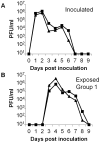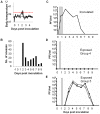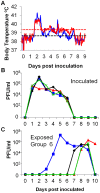Transmission of a 2009 H1N1 pandemic influenza virus occurs before fever is detected, in the ferret model
- PMID: 22952661
- PMCID: PMC3430703
- DOI: 10.1371/journal.pone.0043303
Transmission of a 2009 H1N1 pandemic influenza virus occurs before fever is detected, in the ferret model
Abstract
During the early phase of the 2009 influenza pandemic, attempts were made to contain the spread of the virus. Success of reactive control measures may be compromised if the proportion of transmission that occurs before overt clinical symptoms develop is high. In this study we investigated the timing of transmission of an early prototypic strain of pandemic H1N1 2009 influenza virus in the ferret model. Ferrets are the only animal model in which this can be assessed because they display typical influenza-like clinical signs including fever and sneezing after infection. We assessed transmission from infected animals to sentinels that were placed either in direct contact or in adjacent cages, the latter reflecting the respiratory droplet (RD) transmission route. We found that pre-symptomatic influenza transmission occurred via both contact and respiratory droplet exposure before the earliest clinical sign, fever, developed. Three of 3 animals exposed in direct contact between day 1 and 2 after infection of the donor animals became infected, and 2/3 of the animals exposed at this time period by the RD route acquired the infection, with the third animal becoming seropositive indicating either a low level infection or significant exposure. Moreover, this efficient transmission did not temporally correlate with respiratory symptoms, such as coughs and sneezes, but rather with the peak viral titre in the nose. Indeed respiratory droplet transmission did not occur late in infection, even though this was when sneezing and coughing were most apparent. None of the 3 animals exposed at this time by the RD route became infected and these animals remained seronegative at the end of the experiment. These data have important implications for pandemic planning strategies and suggest that successful containment is highly unlikely for a human-adapted influenza virus that transmits efficiently within a population.
Conflict of interest statement
Figures





Similar articles
-
Vaccine-induced NA immunity decreases viral shedding, but does not disrupt chains of airborne transmission for the 2009 pandemic H1N1 virus in ferrets.mBio. 2024 Oct 16;15(10):e0216124. doi: 10.1128/mbio.02161-24. Epub 2024 Sep 9. mBio. 2024. PMID: 39248566 Free PMC article.
-
Hemagglutinin-neuraminidase balance confers respiratory-droplet transmissibility of the pandemic H1N1 influenza virus in ferrets.Proc Natl Acad Sci U S A. 2011 Aug 23;108(34):14264-9. doi: 10.1073/pnas.1111000108. Epub 2011 Aug 8. Proc Natl Acad Sci U S A. 2011. PMID: 21825167 Free PMC article.
-
Experimental adaptation of an influenza H5 HA confers respiratory droplet transmission to a reassortant H5 HA/H1N1 virus in ferrets.Nature. 2012 May 2;486(7403):420-8. doi: 10.1038/nature10831. Nature. 2012. PMID: 22722205 Free PMC article.
-
Heterogeneity in transmissibility and shedding SARS-CoV-2 via droplets and aerosols.Elife. 2021 Apr 16;10:e65774. doi: 10.7554/eLife.65774. Elife. 2021. PMID: 33861198 Free PMC article.
-
Aerosol transmission of influenza A virus: a review of new studies.J R Soc Interface. 2009 Dec 6;6 Suppl 6(Suppl 6):S783-90. doi: 10.1098/rsif.2009.0302.focus. Epub 2009 Sep 22. J R Soc Interface. 2009. PMID: 19773292 Free PMC article. Review.
Cited by
-
Crossing the scale from within-host infection dynamics to between-host transmission fitness: a discussion of current assumptions and knowledge.Philos Trans R Soc Lond B Biol Sci. 2015 Aug 19;370(1675):20140302. doi: 10.1098/rstb.2014.0302. Philos Trans R Soc Lond B Biol Sci. 2015. PMID: 26150668 Free PMC article. Review.
-
Host and viral determinants of influenza A virus species specificity.Nat Rev Microbiol. 2019 Jan;17(2):67-81. doi: 10.1038/s41579-018-0115-z. Nat Rev Microbiol. 2019. PMID: 30487536 Review.
-
Ferrets as a model for tuberculosis transmission.Front Cell Infect Microbiol. 2022 Aug 16;12:873416. doi: 10.3389/fcimb.2022.873416. eCollection 2022. Front Cell Infect Microbiol. 2022. PMID: 36051240 Free PMC article.
-
Respiratory Bacteria Stabilize and Promote Airborne Transmission of Influenza A Virus.mSystems. 2020 Sep 1;5(5):e00762-20. doi: 10.1128/mSystems.00762-20. mSystems. 2020. PMID: 32873612 Free PMC article.
-
Kinetics and magnitude of viral RNA shedding as indicators for Influenza A virus transmissibility in ferrets.Commun Biol. 2023 Jan 23;6(1):90. doi: 10.1038/s42003-023-04459-0. Commun Biol. 2023. PMID: 36690690 Free PMC article.
References
Publication types
MeSH terms
Grants and funding
LinkOut - more resources
Full Text Sources
Other Literature Sources
Medical
Miscellaneous

